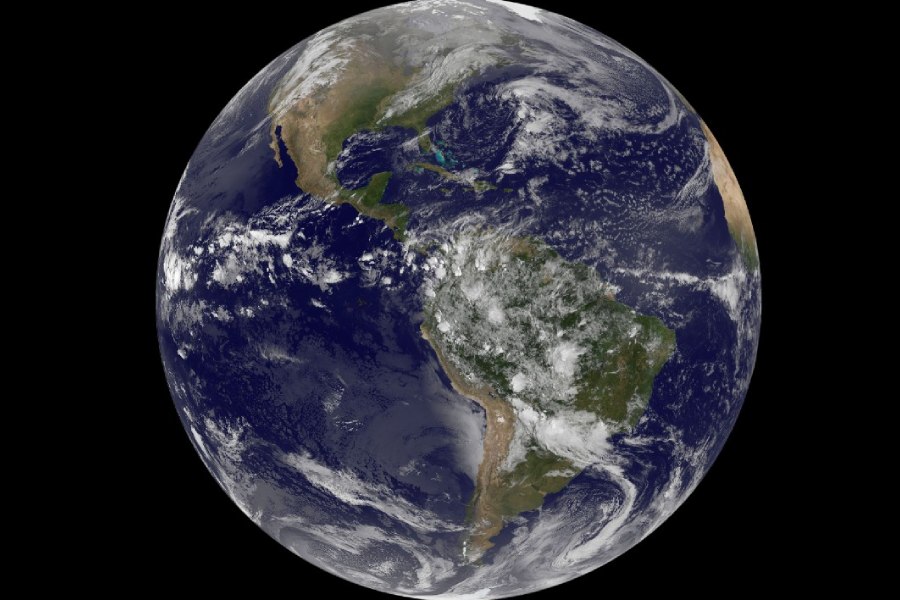Have you ever wondered what precise shape our planet Earth is? Ancient scholars used logic and observations to deduce that our planet is round rather than flat.
However, it took many centuries before explorers circumnavigated the globe, and precise modern measurements convinced the masses that we live in a spherical world.
In this article, we will examine the historical and scientific confirmation over time and share key insights from pioneering philosophers, navigators, and scientists who showed us the right shape of our planetary home.

Is Earth Round?
So, is Earth round? Yes, Earth is round in shape. Specifically, Earth is best described as an oblate spheroid – it bulges slightly at the equator from its perfect sphere shape due to centrifugal forces from its rotation.
Ancient Greek scholars had first deduced Earth’s roundness using logic and lunar eclipse shadows. They conjectured Earth’s spherical shape based on lunar eclipse shadows and other clues that provided early evidence that the Earth is round.
Further proof came as explorers began sailing long distances. As they sailed far distances, the horizon and constellations revealed more proof that the planet curves and is round. So, they noticed the planet’s curvature through the disappearance of ships over the horizon and the shifting constellations in the night sky.
Still, careful experiments and geometric calculations were ultimately required to convince everyone definitively that, yes, Earth is round in configuration. Carefully designed experiments, triangulation measurements, and geometric calculations were needed to convince all people that definitively Earth is round.
Modern space-based observations and photos of Earth fully confirm its spherical nature as the planet rotates on its axis and orbits around the Sun through space.
History of the Belief in a Spherical Earth
The notion of a sphere-shaped Earth emerged in ancient Greece. It was deduced philosophically and backed by careful observations. However, without concrete proof, many cultures and public perceptions continued assuming a flat plane.
Significantly more evidence would accumulate before educated societies uniformly endorsed Earth’s rotundity. The path to acceptance required overcoming objections rooted in perception, culture, and religion over centuries.
Examining the objections, doubts, and differing perceptual frameworks surrounding the spherical Earth concept provides insight. This highlights challenges in supplanting long-held assumptions even in the face of contradicting evidence. But steadily, experiments and mathematical demonstrations ushered acceptance.
Scientific evidence for a round Earth
Careful astronomical observations and mathematical reasoning supported the conception of a spherical Earth back in ancient times. Aristotle provided arguments based on lunar eclipses and ships disappearing below the horizon.
Eratosthenes even calculated the Earth’s circumference. Still, without modern measurement tools, widespread doubt persisted.
As navigation advanced in the 13th century, recognition that Polaris elevation and constellations vary with latitude offered tangible signs of a globular world. Finally, Ferdinand Magellan’s crew completing the first circumnavigation dispelled remaining skepticism about Earth’s shape among European intellectual societies.
Ancient Cultures’ Beliefs
Many ancient cultures imagined Earth was flat. Several perceptions were based on direct experience rather than abstract thought experiments. Night skies inspiration led others like the Greeks to envision spheres.
Ancient beliefs about Earth’s shape were intricately bound to religious explanations for creation, floods, and life itself. Challenging those deep links required extraordinary evidence before precipitating shifts. Philosophies outside the mainstream could not completely erase doubts stemming from tradition.
Babylonians and Greeks
Babylonian astronomy produced the earliest evidence of awareness that the Earth’s curved shadow moves across the Moon during lunar eclipses. This implied a spherical shape long before spaceflight verification.
Aristotle provided influential logical arguments, envisioning Earth as a sphere at the center of concentric celestial spheres.
Key Greek era insights about Earth’s roundness emerged through the study of geometric principles coupled with careful observations of the skies, shipping over horizons, and changing positions of constellations at different latitudes. The mathematization of these clues coalesced gradually into a consensus among natural philosophers of a globular world.

Chinese observation of a round Earth
The Chinese made relatively early recognition that Earth exhibits a spherical form based on observations of day length varying when moving north to south, much like the Greeks noticed shifting celestial pole positions. They did this by combining spatial cues like mountain peaks obstructing more distant sights along with philosophical reflection.
Chinese scholars endorsed Earth’s rotundity independent of Western teaching. While Greek thinkers employed abstract geometry, Chinese justification relied more directly on travel perceptions like pole star angles and remoteness affecting apparent tower heights.
This demonstrates multiple discovery pathways leading diverse cultures toward comprehending Earth’s globular nature when prioritizing direct experience over tradition.
Other ancient civilizations and their views on the shape of the Earth
Ancient Egyptians, Mesopotamians, and Hebrews envisioned Earth as a flat expanse probably surrounded by water based on creation myths and inductive experience. Most early societies lacked maritime trade or mathematical astronomy to prompt conceptual questioning.
Gradual assimilation of Greek and Islamic science seeded recognition of spherical geometries.
Inherited narrative traditions explained existence in geospatial terms.
Challenging inferences drawn from direct perception required the transmission of philosophy and empiricism from other cultures alongside the broader examination of inconsistencies. Even where ideas diffused, resistance to abandoning foundational worldviews persisted for centuries, absent methodical investigation.
Isaac Newton’s Contributions to Our Understanding
Isaac Newton’s physics insights included explaining gravity as a predictable attractive force proportional to mass rather than mystical tendencies.
His laws of motion and universal gravitation provided mathematical formulations that finally allowed for the accurate assessment of Earth’s slightly oblate spheroidal shape caused by rotational forces. Building on Galileo and Kepler’s kinematics discoveries, Newton’s Philosophiae Naturalis Principia Mathematica underpinned modern dynamics.
It enabled definitive quantification of geodesic anomalies like equatorial bulging resulting from a large spinning globular Earth, helping transition acceptance from the qualitative to quantified spherical fact.
Flat-Earth Theory in Historical Context
Despite scientific confirmation of Earth’s rotundity, some 19th-century writers revived doubts stemming from alternative religious exegesis and perceived conflicts with direct experience. Their views found sympathy among social subsets harboring anti-establishment suspicions.
But lacking substantive evidence or explanatory power for observations, most societies marginalized flat-Earth conjectures. Post-Darwinism anxiety over paradigmatic scientific shifts also psychologically primed portions of the lay public to question orthodoxy, even well-supported findings.
Speculation can seem to fill explanatory gaps amidst major transitions in perspective. As science professionalized, flat-Earth conjecture drifted towards extreme contrarianism rather than winning the reopening of serious debate on established sphericity.
Flat-Earth theorists and their arguments
Flat-earth proponents tried marshaling obscure passages from religious texts and selective personal experiences like limited perceptual range and assumed water leveling to cast doubt upon Earth’s roundness. But they failed to formulate scientifically testable alternative systems for phenomena like eclipses, continents, and seasons.
Nor could superseded ancient cosmographies invalidate accumulated measurements, photographs, and consistent predictive frameworks confirming globularity. While curiosity about opposing perspectives serves constructive epistemic purposes, all empirically verifiable evidence perpetually vindicated a spherical model.
Wide acceptance of Earth’s shape persists not from authority demands but because predicting otherwise would continuously prove unreliable or infeasible versus reality’s manifestations across interconnected domains. No flatter model accounts for tests or observations confirming roundness
Conclusion
The truth about the shape of Earth has taken a long, winding journey to be firmly established. From ancient cosmological philosophies to modern scientific institutions, we have witnessed an evolution in perspectives and proofs until the clear picture finally emerged. So, is Earth round?
Yes, Earth is round in shape, specifically an oblate spheroid that bulges slightly at the equator due to its rotation. Ancient Greeks had first deduced Earth’s spherical form using logic about lunar shadows. Further proof of Earth’s rotational roundness came as explorers noticed ships disappearing over horizons and shifting stars.
However, carefully designed experiments with geometry were required before widespread acceptance that definitively, Earth is round. Modern space-based photography confirms Earth’s rounded shape as it rotates on its axis while orbiting the Sun.
Though not a perfect sphere, observations and measurements leave no doubt that the geometry of Earth is that of a rounded globe rather than a flat plane. Multiple lines of evidence definitively converge on Earth, exhibiting a confirmable bulging spherical form through space.
While some skepticism continued for centuries prior, perpetual verification from predictions relying on an orb-shaped world has debunked any lingering doubts about whether Earth is round.
